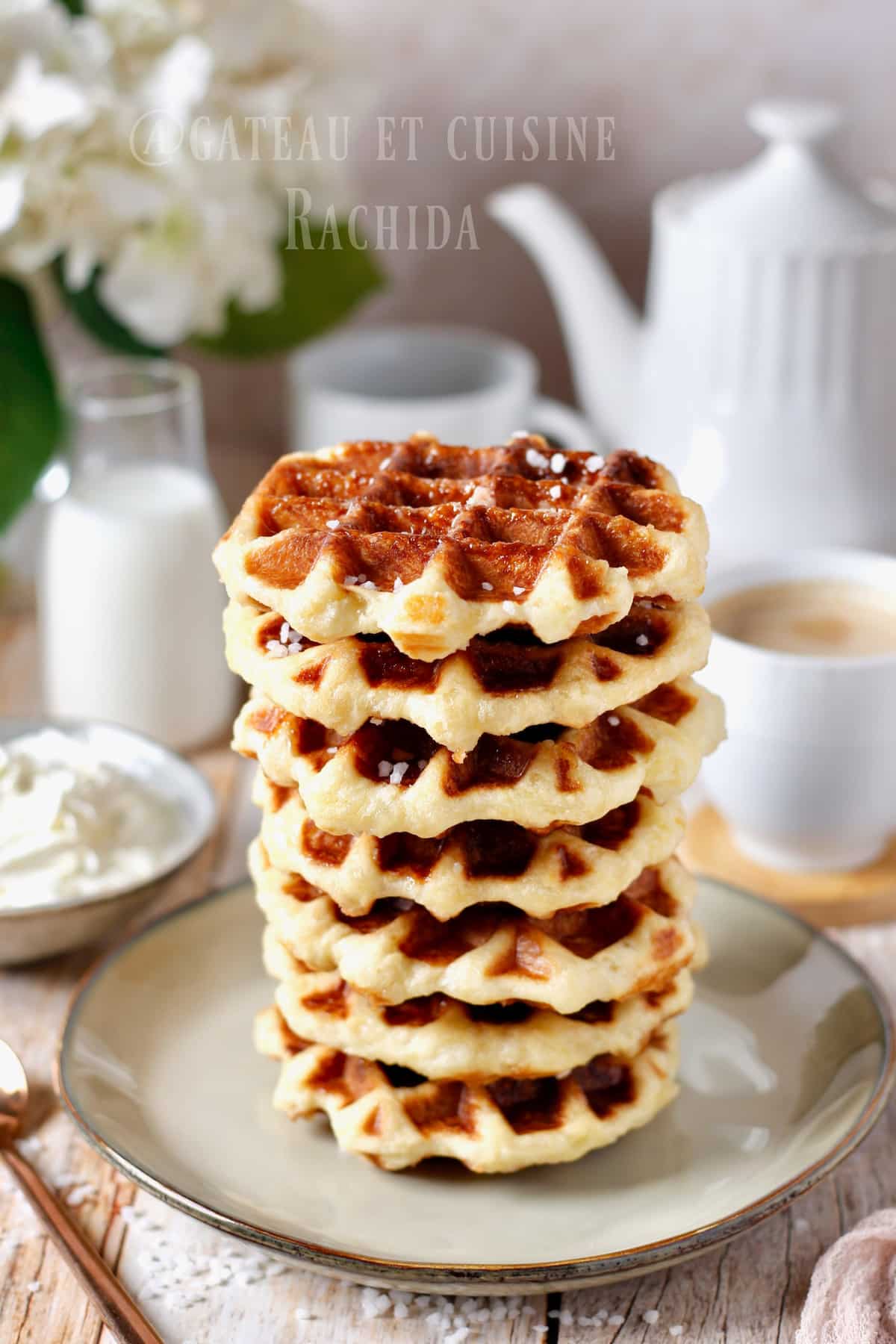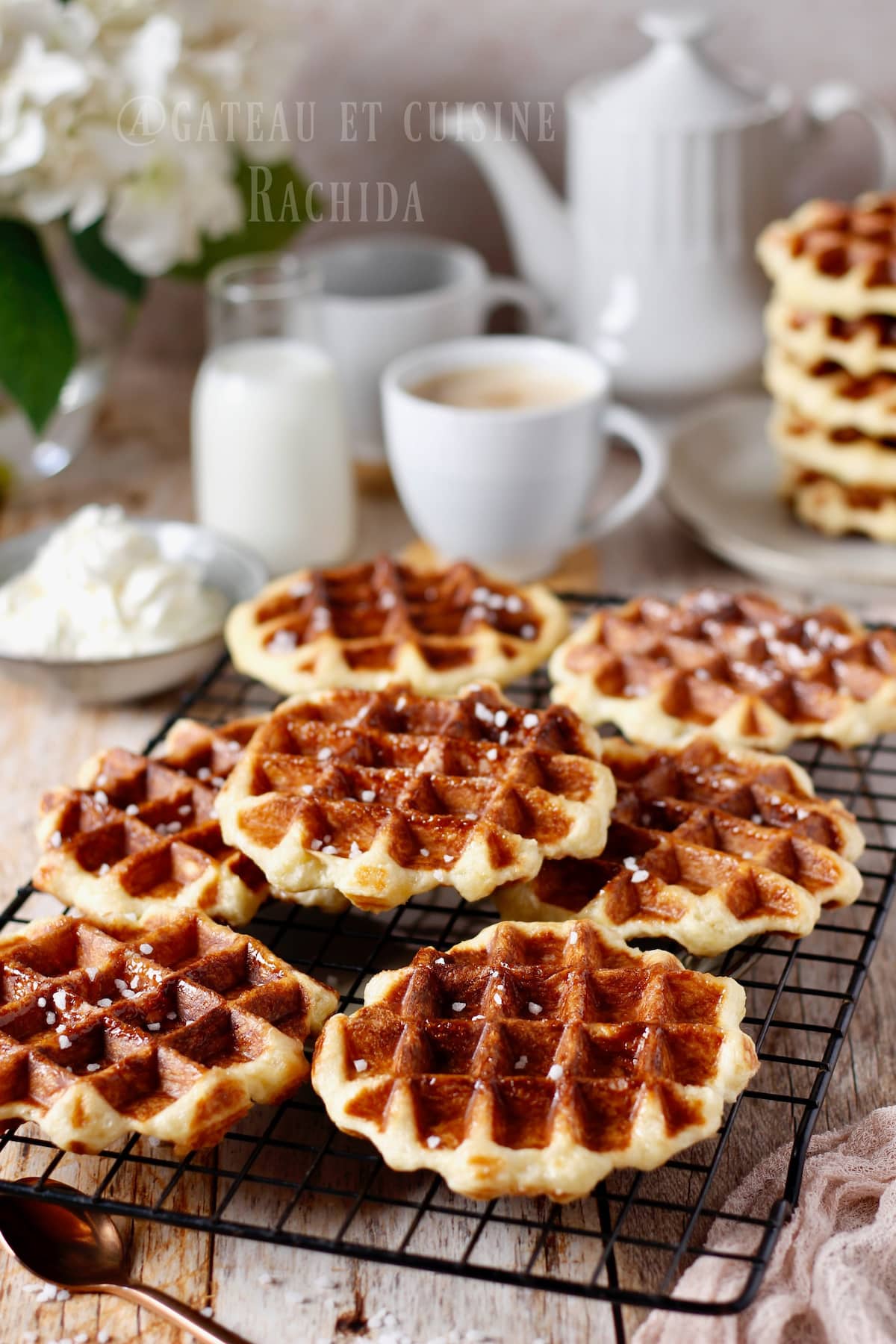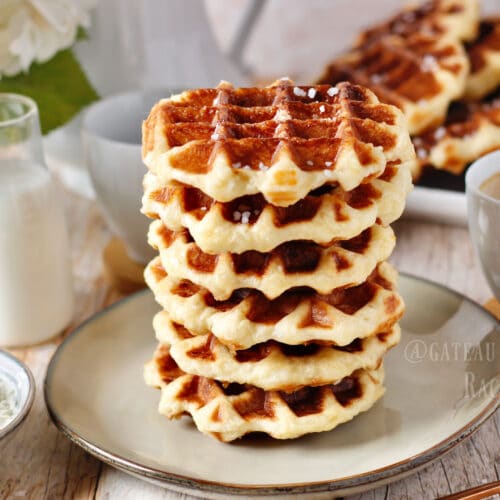The Liège waffle is one of Belgium’s traditional recipes, known the world over. A Liège speciality that combines crispness and softness.
Prepared with baker’s yeast, it differs from the famous Brussels waffles by its brioche-like texture and the addition of pearl sugar, which gives it an irresistible crispness and caramelization.

The authentic Liège waffle
Every country has famous recipes that have helped make its culinary heritage known the world over. Such is the case in Belgium, where the Liège waffle and the Brussels waffle are two of the country’s specialities. Even if you’ve never had the chance to make them yourself, you’ve probably already tasted them.
Today, I’d like to show you how to make a soft, crispy Liège waffle, with exquisite caramelization and crunchy pearl sugar.
Table of Contents
What you’ll love about the Belgian Liège waffle recipe
Irresistible texture: Liège waffles are soft on the inside and crispy on the outside. The baker’s yeast gives it a brioche-like texture, and the pieces of pearl sugar that caramelize during baking add crispness and an inimitable taste..
Difficulty level: A very simple recipe that’s sure to work every time.
Belgian Tradition: If you enjoy discovering recipes from other countries, the Liège waffle embodies artisanal craftsmanship passed down through generations and is a quintessential symbol of Belgian patisserie.
Garnish: Traditionally, the Liège waffle is self-sufficient and can be eaten on its own, just after baking, to enjoy the melting pearl sugar. However, for those with a sweet tooth and who aren’t concerned about calories, you can garnish them with various accompaniments such as spread, whipped cream, fresh fruit or ice cream.
Storage: Even if they are eaten up quickly, if you’re not many at home, you may want to store them. Fortunately, they can be stored in the freezer for up to 2 months. This is a very practical option. Simply defrost the desired quantity and reheat to restore their freshness, as if you had just prepared them. 
Precision on the waffle maker
Although the recipe is not complicated, here are a few tips:
Choosing the right waffle maker: Depending on the waffle maker you use, you’ll get thicker or thinner waffles, and this will also influence their crispness. If possible, invest in a Belgian waffle maker to guarantee optimal results.
The Frifri waffle maker is by far the best value for money. I had the opportunity to try it out at my cousin’s house in Brussels, and the results were excellent. I plan to buy it soon with the special Liège waffle plate.
If you like thick waffles, this is the one for you, or take one of the Lagrange brand, which are also very good.

I have a Krups waffle maker which gives a very good result but it flattens the waffle a little. I don’t close it all the way and leave it ajar to get waffles just the way I like them, neither too thin nor too thick.
The advantage of this waffle maker is that you don’t need to turn the waffle over, so you get a beautiful golden brown and caramelization. The downside is that the plates are not removable for easy cleaning.
Tips and tricks
Choosing pearl sugar: I only had chouquette pearl sugar left, but I wouldn’t recommend it as it tends to melt and make the dough stickier. The waffles were great despite everything, there was the crunch we like so much and a good caramelization. Use pearl sugar specifically for Liège waffles, which is larger (caliber 40).
Let the dough rise well: Just like with brioche dough, it should be left to rise until it doubles in volume. The time indicated may be longer or shorter depending on the room temperature.
Order of ingredients: Add the butter only after kneading the dough to activate the gluten (which gives the waffles a good texture). The pearl sugar should be added after the dough has first risen, to prevent it from melting.
Preparation steps :
| NB: Find the complete recipe with detailed ingredient quantities in the recipe card at the end of the article, which you can also print out. Below are the instructions, which you can also view in images. |
1. Pour the flour and salt into the bowl of your stand mixer or into a mixing bowl, taking care to place the salt at the bottom so that it doesn’t come into contact with the yeast (as it could deactivate it).
2. Add eggs, sugar, vanilla sugar, dry yeast or crumbled fresh yeast and milk. Start Kneading for 5 min on low speed, until the dough wraps around the hook and is smooth and uniform.
3. Add the soft butter and knead on low speed for 10 minutes, until well incorporated. Scrape down the sides of the bowl once or twice to facilitate the process. The dough will stick to the bottom of the bowl, but will wrap around the hook.
4. Scrape down the sides of the bowl to form a dough ball. Cover the bowl with cling film and then with a towel.
5. Place in a draught-free place and leave to rise for 1.5 to 2 hours, until doubled in size. Cover with a blanket if it’s cold.
6. After this time, add the pearl sugar in two or three stages using a bench scraper. You can add it using the stand mixer’s hook, running it just long enough for the sugar to be fully incorporated.
7. In hot weather, the dough may be sticky. If so, put it in the fridge for a while so that you can form balls easily.
8. Weigh small portions of dough, each weighing 80 to 100 grams (2.8 to 3.5 oz), here 80 g (2.8 oz).
9. Lightly oil your hands, then shape into balls and place on a baking sheet lined with cling film or baking parchment. Leave to rise uncovered for 30 minutes.
Cooking Liège waffles
1. After this time, preheat your waffle maker according to the manufacturer’s instructions.
2. Place a ball of dough in the center of each section of the waffle maker and close it.
3. Bake for about 3 to 4 minutes, until golden and crisp. If you have a rotary waffle maker, turn over halfway through cooking. After 2 min, check for doneness and continue cooking.
Tip: If your waffle maker flattens the waffle too much, don’t close it completely with the flap. Leave it slightly ajar.
4. Be careful not to over-caramelize it, or the caramel will become bitter. Keep an eye on it towards the end by opening the waffle maker 1 or 2 times.
5. Place cooked waffles on a wire rack. Allow to cool slightly before serving.

Storage
1. Once your waffles have cooled, you can store them for 2 to 4 days in an airtight container at room temperature. Simply reheat in the microwave or in a covered skillet.
2. Place the waffles in the hot skillet, cover and turn off the heat. After 5 minutes, reheat the pan and turn off the heat. Continue until the waffles are heated through.
3. You can also frozen them for up to 2 months in an airtight container separated by cling film. You can take out the desired quantity and reheat it as indicated above.

Belgian Liège waffles Recipe
INGREDIENTS
- 500 g all-purpose flour (17.6 oz)
- 2 eggs
- 35 g granulated sugar or brown sugar (1.2 oz)
- 8 g dry baker’s yeast (0.28 oz) or 20 g fresh baker’s yeast (0.7 oz)
- 180 ml milk (6 fl oz) at room temperature (if it's cold, warm it just enough to lose its chill. It should not be hot, as this will kill the yeast)
- 2 large pinches of salt
- 1 packet of vanilla sugar or 1 teaspoon of vanilla extract
- 270 g softened butter (9.5 oz)(you can use less, 200/250 g, but the taste will be less intense)
- 200 g pearl sugar (7 oz)(preferably large caliber, specifically for Liège waffles. You can use a little less or more)
PREPARATION
- You can see the steps in images and my tips in the article.
- Pour the flour and salt into the bowl of your stand mixer or into a mixing bowl, taking care to place the salt at the bottom so that it doesn't come into contact with the yeast (as it could deactivate it).
- Add eggs, sugar, vanilla sugar, dry yeast or crumbled fresh yeast and milk. Start Kneading for 5 min on low speed, until the dough wraps around the hook and is smooth and uniform.
- Add the soft butter and knead on low speed for 10 minutes, until well incorporated. Scrape down the sides of the bowl once or twice to facilitate the process. The dough will stick to the bottom of the bowl, but will wrap around the hook.
- Scrape down the sides of the bowl to form a dough ball. Cover the bowl with cling film and then with a towel.
- Place in a draught-free place and leave to rise for 1.5 to 2 hours, until doubled in size. Cover with a blanket if it's cold.
- After this time, add the pearl sugar in two or three stages using a bench scraper. You can add it using the stand mixer’s hook, running it just long enough for the sugar to be fully incorporated.
- In hot weather, the dough may be sticky. If so, put it in the fridge for a while so that you can form balls easily.
- Weigh small portions of dough, each weighing 80 to 100 grams (2.8 to 3.5 oz), here 80 g (2.8 oz).
- Lightly oil your hands, then shape into balls and place on a baking sheet lined with cling film or baking parchment. Leave to rise uncovered for 30 minutes.
Cooking Liège waffles
- After this time, preheat your waffle maker according to the manufacturer's instructions.
- Place a ball of dough in the center of each section of the waffle maker and close it.
- Bake for about 3 to 4 minutes, until golden and crisp. If you have a rotary waffle maker, turn over halfway through cooking. After 2 min, check for doneness and continue cooking.
- Tip: If your waffle maker flattens the waffle too much, don't close it completely with the flap. Leave it slightly ajar.
- Be careful not to over-caramelize it, or the caramel will become bitter. Keep an eye on it towards the end by opening the waffle maker 1 or 2 times.
- Place cooked waffles on a wire rack. Allow to cool slightly before serving.
Thank you for visiting my blog and your comments.
You can follow me on my Youtube channel
